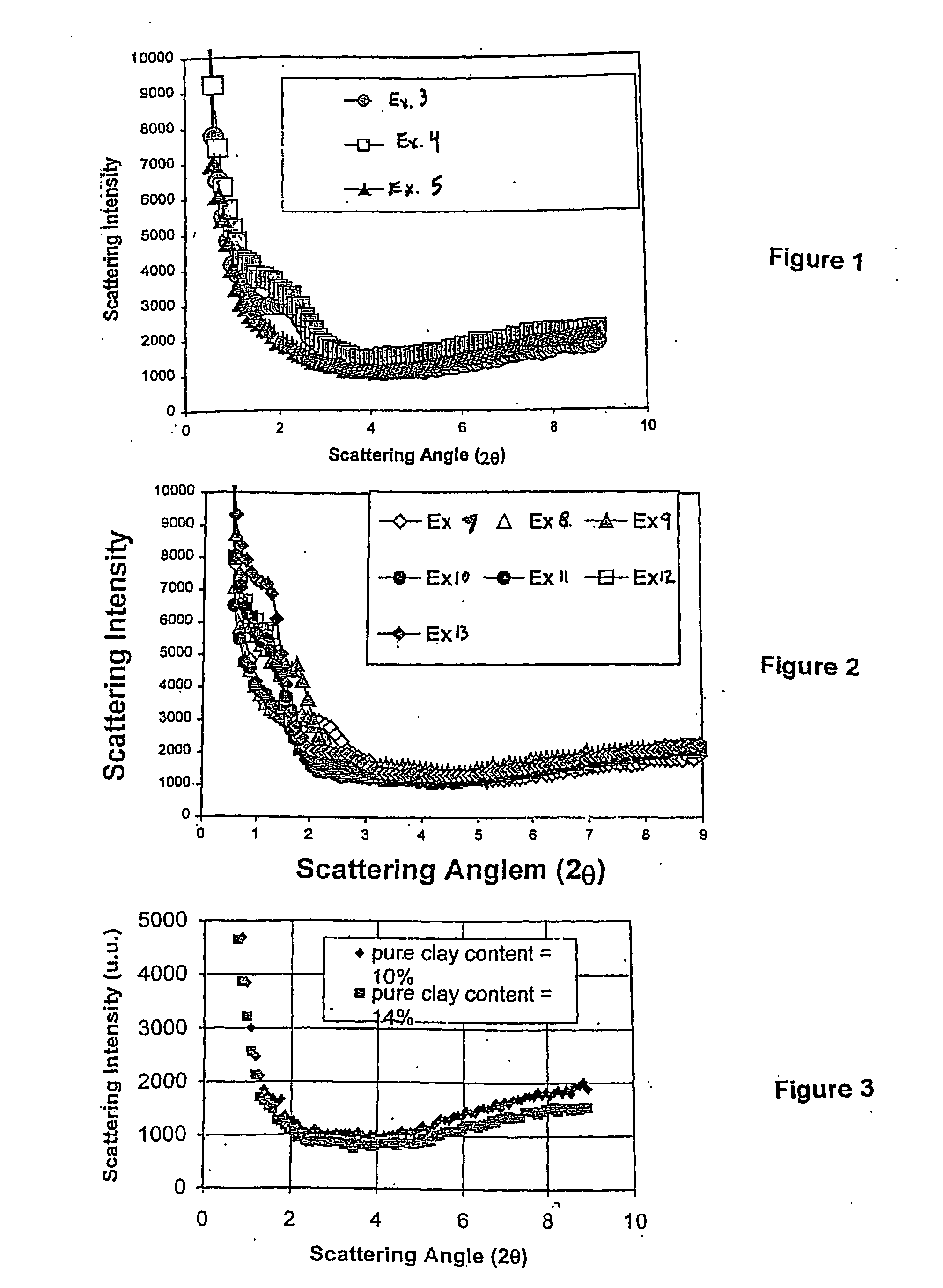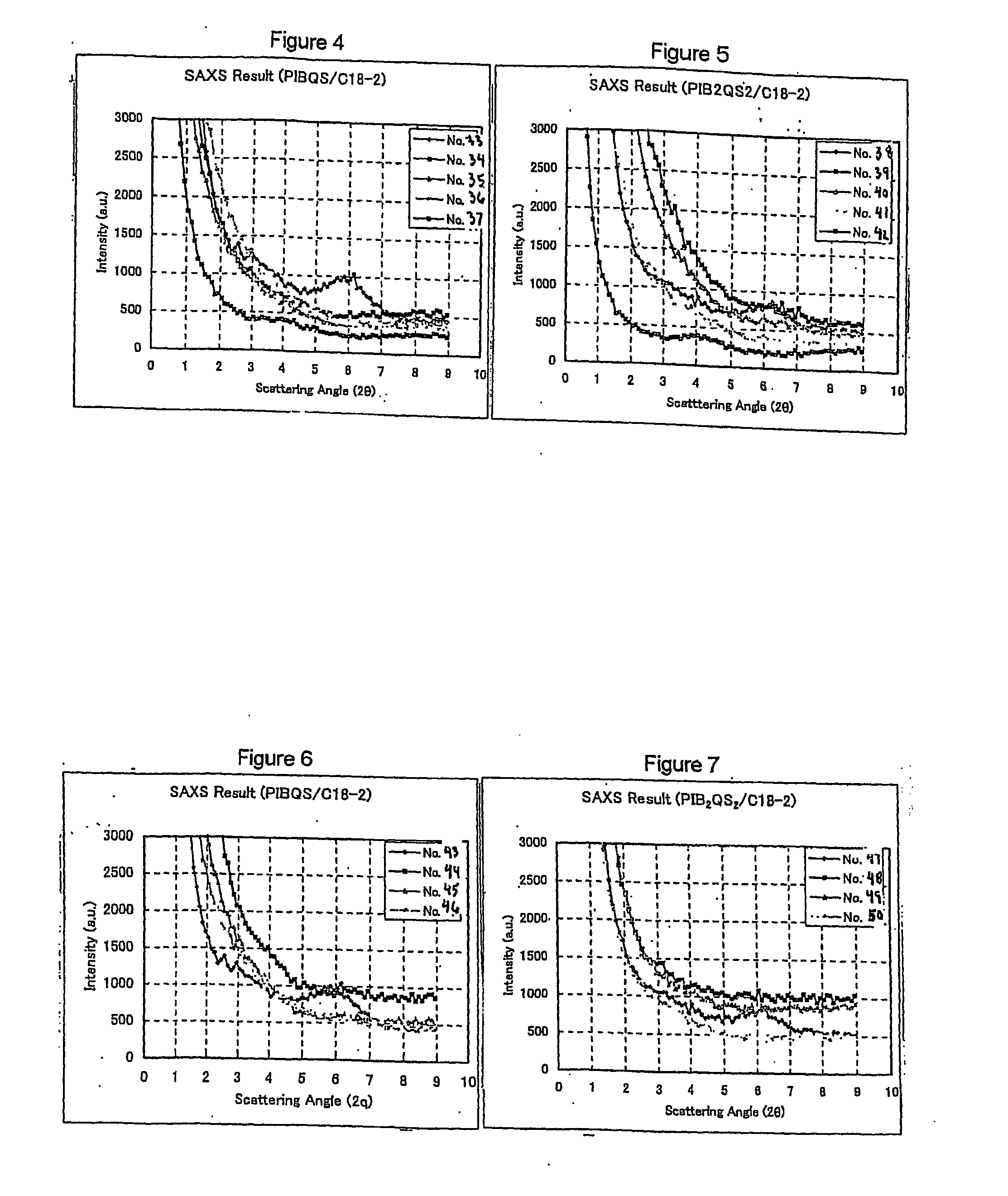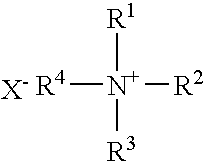Method for clay exfoliation, compositions therefore, and modified rubber containing same
a technology of modified rubber and clay, which is applied in the field of clay exfoliation, can solve the problems of oxidative degradation, chain cleavage, and lower damping properties, and achieve the effects of low gas permeability, low gas permeability, and low gas permeability
- Summary
- Abstract
- Description
- Claims
- Application Information
AI Technical Summary
Benefits of technology
Problems solved by technology
Method used
Image
Examples
example 1
Synthesis of Poly(isobutylene-co-N,N-dimethylvinylbenzylamine)
[0069] To a 1 L N2 purged bottle was added 173.2 g of 23 wt. % isobutylene in hexane and 272.6 g of methyl chloride with stirring. The bottle was cooled to −78° C. and 1.5 mL dimethylacetamide (Aldrich), 0.8 mL di-t-butylpyridine (Aldrich), 1.98 g of α,α,α′,α′-tetramethyl-1,4-benzene dimethylchloride (prepared according to the synthesis set forth above) and 1.38 g of N,N-dimethylvinylbenzylamine (Aldrich) were added. Upon addition of 4 mL of TiCl4 (Aldrich) the polymerization was initiated and the temperature rose to −60.7° C. After 43 minutes, an additional 2 mL of TiCl4 was added. After 90 minutes, the reaction was terminated with 20 mL methanol. The methyl chloride was evaporated and the resulting hexane solution extracted with 300 mL methanol. Evaporation of the solvent yielded poly(isobutylene-co-N,N-dimethylvinylbenzylamine) with the following properties: Mn=9.4×103 g / mol, Mw=1.34×104 g / mol. Integraion of the N—(CH...
example 2
Organo-Montmorillonite
[0070] The layered silicate was a montmorillonite (a natural Bentonite clay from Southern Clay Products, Gonzales, Tex.) with a charge exchange capacity (CEC) of about 98 mequiv / 100 g. The clay was organically modified with benzalkonium chloride (Aldrich, Milwaukee, Wis.) through a cation exchange reaction. In this reaction, 200 mL of a benzalkonium chloride / water solution (30 wt. %) was used to treat 50 g of the clay. The reaction was performed in a sealed flask and the reactants were shaken for 20 hrs at 23° C. The mixture was then filtered through a filter paper. Thereafter, the clay was dispersed in another 200 mL of the benzalkonium choride / water solution. The process was repeated three times. Finally, excess benzalkonium chloride was removed using isopropanol to wash the product. After vacuum drying, the modified montmorillonite contained about 45% organo-matter (i.e., benzalkonium), as measured by thermo-gravity analysis (TGA). TGA was carried out on eq...
examples 3-5
Clay Particle Exfoliation
[0071] The required amounts (from Table 1 below) of toluene, butyl rubber (MH-11), treated silicate (example 2), and a 10 wt. % solution of poly(isobutylene-co-N,N-dimethylvinylbenzylamine) (Example 1) in toluene were charged into a 950 mL bottle. The bottle was then placed on a mechanical shaker for 24 hours, and the polymer and treated silicate were dissolved in toluene. Excess surfactant was then extracted with EtOH and the resulting material was then drum dried. Small angle x-ray scattering (SAXS) shows that addition of poly(isobutylene-co-N,N-dimethylvinylbenzylamine) improves the exfoliation of the clay into the butyl rubber (FIG. 1). Particularly, in example 5, where no montmorillonite lamellar peak was observed, indicating that the clay is completely exfoliated.
TABLE 1Example 3Example 4Example 5Toluene ml300255 ml180 mlMH-11 (g)4040 40 Treated silicate (g)44 4 2562-71-1*0 45 ml120 ml
*2562-71-1 is a 10 wt. % solution of poly(isobutylene-co-N,N-di...
PUM
| Property | Measurement | Unit |
|---|---|---|
| Temperature | aaaaa | aaaaa |
| Temperature | aaaaa | aaaaa |
| Temperature | aaaaa | aaaaa |
Abstract
Description
Claims
Application Information
 Login to View More
Login to View More - R&D
- Intellectual Property
- Life Sciences
- Materials
- Tech Scout
- Unparalleled Data Quality
- Higher Quality Content
- 60% Fewer Hallucinations
Browse by: Latest US Patents, China's latest patents, Technical Efficacy Thesaurus, Application Domain, Technology Topic, Popular Technical Reports.
© 2025 PatSnap. All rights reserved.Legal|Privacy policy|Modern Slavery Act Transparency Statement|Sitemap|About US| Contact US: help@patsnap.com



